Effect of Altered States of Consciousness on Art
| ✅ Paper Type: Free Essay | ✅ Subject: Arts |
| ✅ Wordcount: 3660 words | ✅ Published: 03 Nov 2020 |
Art in Relation to Physical and Mental Illness
Yayoi Kusama
Yayoi Kusama is a contemporary Japanese artist who is known for her extensive use of polka dots and her infinity installations (Cole, 2019). Suffering from a mental illness as a child, and thoroughly abused by her mother, she persevered by using her hallucinations and personal obsessions to create her artworks.
Kusama was born in 1929 in rural Japan into a family of merchants (Yoshimoto, 2005). Kusama’s wish was to become a painter, so she began painting many pictures from the age of 10. However, her mother deeply opposed her artistic practice and was told she was not allowed to paint. Kusama states her mother ‘took away all my ink and canvases’ and was told that one day Kusama ‘would have to marry someone from a rich family and become a housewife’ (Tate, 2012). Her mother often abused her, and around the age of ten Kusama began having hallucinations and thoughts she could not control. She described these as ‘flashes of light, auras, or dense fields of dots’ which would come to life, multiply and engulf herself and her surroundings in a process she called ‘self-obliterations’ (Zelevansky, 1998). These acts provoked her mother more as she thought her ‘visions’ were ‘crazy talk’ and did not tolerate them.
At age ten, art become an escape for Kusama. (Figure.) an image of Kusama’s first known drawing, a portrait of her mother. As can be seen, the woman is covered in polka dots, including the background. They look like raindrops or snowfall surrounding the woman, which suggests space and depth. The repetition of polka dots and objects covering all surroundings becomes a reoccurring concept in Kusama’s artwork. At this young age, the repetitive image is already basic to Kusama’s imagination about the structure of reality and constitutes an extreme element in her visual description of it (Munroe, 1989). Kusama uses the polka dot to cover and conceal people, the environment, and everything around. It is a metaphor of giving up her identity, abolishing uniqueness, and becoming one with the universe – or ‘self-obliteration’. This would suggest Kusama is covering the image of her mother in dots was an attempt to get rid of the one thing that brought her the most trauma in life. The use of dots has become a defence mechanism in reference to using something to eliminate another.
A great deal of her work explores her general fear with her own body and the male gentiles. Kusama states that this developed as a child, her father had many affairs with other women. Her mother would send her daughter, Kusama, to spy on her father. She witnessed a “sex act” that left a deep emotional scar (Tate, 2012). Witnessing her father with a different woman must have been really traumatic for a young sensitive person. According to Kusama, ‘the fear that entered though her eyes had ballooned inside her’(Carter, 2017), it reached to a point to where she was ‘assaulted by countless phallic visions‘ (Yoshimoto, 2005). Since then Kusama has associated the idea of sex and the male genitals to something dirty and bad.
The long-standing fear of sex has lead Kusama to the creation of her phallus-covered items such as ladders, shoes and chairs. She debuted her first installation in 1962, titled Accumulation No.1 (Carter, 2017). I was intrigued by the juxtaposition of the standard form of a armchair and the strange tube-like fabric additions, the soft and hard forms and surfaces seems to emit some sort of tension. On the other hand, I also find it disturbing and uncomfortable as the phallic sculptures appear to be suffocating the armchair. The use of the colour grey creates an emotionless and unsettling feeling, is this what Kusama was intending to do? The repetition of the phallic form gives the work a sense of embodiment and power, perhaps this work was a way to help Kusama overcome and confront her sexual phobias. Alexandra Munroe, a scholar, explains, “her ambition for supremacy over men and over sexuality is relentlessly expressed in her repetitive and aggregate use of the phallus form, which can be interpreted as an aggressive will and fantasy to defy oppressive male power by possessing it symbolically herself” (Munroe, 1989). Kusama has used the phallus as a will to possess her tormentor’s power. The rejection of her father and her protest against masculine domination in Japanese society angered Kusama from an early age. Kusama objected to follow, her art has abled her to possess and control thousands of penises giving her a sense of power and freedom from male oppression.
Today at the age of 90, Kusama still continues to have hallucinations (Yayoi Kusama and psychedelic schizophrenia, n.d.). Art is a form of medicine for Kusama…..
Giorgio De Chirico
Giorgio De Chirico was an Italian painter (1888-1978) turned his migraine aura into stunning paintings. De Chirico is known for developing a unique style of metaphysical art that became an inspiration for the surrealist art movement of the 20th Century. The aura-like paintings profoundly influenced famous surrealists like Salvador Dali, Rene Magritte, and Max Ernst. During his life Chirico suffered from various health disorders, however, one helped in reaching his artistic goal: the migraine aura and its consequent hallucinations.
De Chirico’s view on reality was influenced by his health disorders: the migraine aura. For the whole of his life he was never given a diagnosis: he was unaware that he suffered from it but experienced the unusual symptoms, the hallucinations (Chirchiglia, 2018). His diagnoses was post-mortem by art historians and researchers which questions if he did really suffer from an illness. The total ignorance about the illness from which he suffered is reflected in his writings, from the Memoirs to Ebdomero. Where not only his total unconsciousness is evident, but also the consequences that it entailed, especially on the level of personality, altered by and ego magnified the fact of “seeing what others did not see”. In 2003, researchers Nicola and Podoll combined through De Chirico’s autobiographical writings and discovered that his experiences are consistent with migraine. In which De Chirico clearly asserts that he does not trust himself and his perceptions, he says that he is used to ‘not trusting appearances’, he remembered in his youth ‘appearances had deceived him’.
Very common is the appearance of optical and luminous phenomena, of lights or zig zags, real holes in the perceptual field (scotomas) or even visual hallucinations The consequences are taking into account by the famous neurologist Oliver Sacks in his Migraine, published in 1999, among the main ones, he includes: hallucinations and complex disorders or visual perception, difficulty in perception of your own body, states of doubling or multiplication of consciousness, distorting of temporal perception. Each one of these symptoms can be found in the surrealist art of Giorgio De Chirico.
Many migraine sufferers (artists included) share the view that migraine aura is not only a disease but also a sort of artistic privilege or gift- to this regard Nietzsche himself stated ‘illness can become an energetic stimulant to live, to live more’. It goes without saying that migraine aura qualifies as a real support of perception and therefore of a redescription of reality, a revealed reality. As mentioned, one of the most frequent visions for those in the grip of a hallucination produced by migraine aura, are zigzag shapes presented in works such as il rimorso di Oreste and La battaglia sul ponte, (both from 1969).
Louis Wain
Schizophrenia is a psychological abnormality that affects approximately 1 person in 100. (Johnstone, 2003). About 1% of the population is affected by schizophrenia (Mueser, 2004). Schizophrenia is characterized by distortions in thinking, perception, emotions, language, sense of self and behaviour. Common experiences include hallucinations (hearing voices or seeing things that are not there) and delusions (fixed, false beliefs) (Schizophrenia, 2019).
Louis Wain was an English artist known for his illustrations and prints of anthropomorphized cats playing golf or having tea, Figure. At age 57, he was diagnosed with schizophrenia and Wain was sent to psychiatric institution where he spent the last fifteen years of his life (Ferreira, 2018). Not only his personality was affected, his works of art also began to have a style that was less similar to his initial illustrations. Before, his illustrated cats seemed lively and playful. The smiling and happy cat portraits that featured nice floral backgrounds slowly transformed. They now begin to show different traits, they have turned more geometric and colourful. The rough lines of vivid colour in the background have ‘electrified’ releasing auras of electrical activity radiated from the cats. The cats themselves now appear to be more fearful, with ears turned backs and their eyes looking in peculiar directions. The abstraction continued until the cats were no longer perceivable and all that could be seen is a form made up by symmetrical repeating patterns.
In the past, the understanding of mental health treatment had not been developed and Wain was never official diagnosed (Cute Cats and Psychedelia: The Tragic Life of Louis Wain , 2016). The pictures above (figure.) where collected by Dr Walter Maclay who was interested in the effect of mental illness on art. He placed them in chronological order in what he thought was the progression of Wains schizophrenia (Wrathall, 2000). In my opinion, I don’t see this piece as being totally disorganized and fragmented, we can only assume the last piece is a depiction of a cat although it is hard to see. The colour and style to me looks similar to a painting which has been created under the influence of a drug. Comparing the last pieces to a LSD experiment conducted by Oscar Janiger (Figure.), they look remarkably similar.
Drug Induced Hallucinations
Alex Grey
Alex Greys’ body of work spans a variety of forms including performance art, process art, installation art, sculpture, visionary art and painting (Conscious Awareness, N.D). Grey’s paintings are colourful and full of vibrant detail. Technically, I can really appreciate the art he has created. Grey spent five years at Harvard Medical School working in the anatomy department studying the body and preparing cadavers for dissection prior to becoming a full time artist (Episode 56 – Alex Grey & Allyson Grey, 2016). This shows in his work, for me, his work has lost its sense of human touch. (Figure 1) His work has little warmth an no humour, his paintings appear to be similar to a diagram you may find in a medical journal or encyclopaedia. This could well be his intention making his artwork appear factual validating his ideas on spirituality. There is a feeling of emptiness which can sometimes be unsettling.
What is Grey trying to communicate in his artwork? What I deduce from Grey’s paintings is that our anatomy our physical bodies as a whole are nothing but flesh and bone with no spiritual quality. There isn’t any depiction of emotions, but what is important is our minds, or something that connects us with emotions gives us feelings and emotion. Our translucent bodies and physical appearance is an illusion to our mind and the naked eye. That our spirituality, our psyche, is what connects us truly, it depicts the difference between love and lust.
Pablo Amaringo
Pablo Amaringo (1938- 2009) was an admired Peruvian artist, renowned for his intricate and colourful series of landscapes, that have come to be known as Ayahuasca visions, that look like a paradisiac world. For example (fig ), is heavily filled with patterns, leaves, flowers, and swarming with a countless amount of humans, hybrid, heavenly and godly-like beings. These bright and vivid paintings represents Amaringo’s otherworldly visionary experiences, after drinking the entheogenic plant brew ayahuasca (Pablo Amaringo – Artist, Painting, Spirituality , n.d.). Ayahuasca is a brew made form leaves of the Psychotria viridis shrub. The drink was used for medical, spiritual and religious purposes by the indigenous population of the Amazon (Domínguez-Clavé, et al., 2016). The brew is said to have a heady essence reminiscent of the forest and contains the most potent psychoactive compound know, DMT (Ahimsaplanthealing, 2018). Consuming it induces violent gastrointestinal purging and spectacular visions (Nimmo, n.d).
Other Altered States of Consciousness
Salvador Dali
Sigmund Freud, an Austrian psychologist founded psychoanalytic theory. The success of this theory puts forward that aesthetics and art are built on human unconscious. The subconscious is a special mental state and a person’s mental process (McLeod, 2009). During the 1900’s, Freud published ‘The Interpretation of Dreams’, a book on dream psychology on what he explained how dreams showed the path to understanding the unconscious mind. He explained in our dreams the imagery and symbols could not only reveal the dreamers hidden feelings, and that the unconscious could communicate through imagery and symbolism.
Freud holds that there are instincts and desires which cannot be accepted by rationality and morality in the bottom of human’s psychology. The most intense desire of the id is sexuality. Although it is depressed by realistic norm, it constantly strives for self-satisfaction and frequently manifests in the form of dream. Dream becomes a form reflecting the reality of subconscious. Freud holds that the id of subconscious shall not be repressed. When repressed original impulse or desire which do not conform to social norm are expressed in constructive way conforming to social requirements. Such a psychological defense mechanism is sublimation, and forms such as painting, dancing and literature are embodiments of sublimation. All of them are the most common ways of expression for visualization of subconscious–visual arts activities. Among which, drawing is a good abreaction way. From the standpoint of psychoanalysis, materials in dream are the objective expression of subconscious. Creation of visual image is an embodiment of id surmounting social norm.
After World War One, Surrealism became popular among artists due to the hardship of life brought upon them by the war. Artists and intellectuals wanted to find a way to escape the bleakness of reality. They wanted to reform in their own way, and the work of Freud proved to be influential in this regard, by helping artists tap into the subconscious aspect of their brain.
https://1stwebdesigner.com/modern-surrealism/
Freud believed that dreams are created on our living and life experiences. The reality is visible and real compared to the dreamland which is internal, deceptive and invisible. Everybody dreams, but each dreamland is unique, it can be strange, ecstatic, and thrilling. Subconscious is the best way to set the sheltered ‘inner-self’ free. Ones dreams can take them to other worlds and dimensions (Thunderbird, 2013). Our world, which we believe to be unique and absolute is only one in a cluster of consecutive worlds and realities.
Surrealism creates a bridge amongst the physical and realm and the domain of dreams and illusions (YiTing, 2019). The term ‘Surrealism’ was introduced by Guillaume Apollinaire who was a French poet and writer. He used the term to describe Jean Cocteau’s ballet Parade and his own play The Mammaries of Tiresias (Surrealism, In the Beginning, 2019). Therefore the era of surrealism began. The art movement of surrealism came as a reaction to Freud’s psychoanalysis, and was influenced by his psychoanalytic principles. Many artist such as Andre Breton, Salvador Dali and Max Ernst were very interested with the subconscious: with dream, hallucinations and trances. Often they produce surreal, dream-like and unconscious works.
Salvador Dali based his work off Freud’s theory of dreaming. Freud’s work impressed Dali which led him to enter an artistic stage, where he invented what he called ‘the paranoiac critical method’. This method was used to shape the information of his subconscious. This technique consists of invoking a paranoid state. A fear that one’s either being manipulated or targeted on controlled by external forces. (Dali Paintings , 2011)
In paintings of Dali the representative of surrealism, visual signs, such as ants, bread, soft clock, walking stick and drawer, can be frequently seen. These which are closely related to his childhood and reflection of his false or true childhood memory. In Dali’s landscape oil painting, The Persistence Of Memory, 1931, (Figure 2). The leftmost clock is invaded by ants one of Dali’s personal phobias, considered to be a symbol of decay. Dali devoted all his love to the a small injured bat during his childhood.
But one day, nightmare came, his favourite small bat was surrounded by a crowd of crazy ants: the bat was beaten black and blue, trembling with pain at the last gasp. He took up the bat and lifted it to his mouth, crunched the head of the bat and threw it into the water (Costa.R, 2015). Therefrom, ant had accompanied with Dali. The image of ants have remained in his mind, these images reflect Dali’s study of Freud’s theories and its approach to a person desires and paranoia of the human mind. In Dali’s case the unconscious fear of death alluded to in this painting.
In the middle of the painting, a rounded grey human-like figure can be seen in a dream state, which could possibly resemble Dali’s face. Looking closely at the detail, the figure form has one eye closed with curvy eyelashes as it falls into a dream state suggesting that this landscape is only accessible only through sleep. The long eyelashes could symbolize female sexuality……
The three watches look very soft, almost appearing to look like melting cheese- seemingly contradicts the significance of time itself…..
Some art scholars believe that Dali’s melting clocks may symbolize Albert Einstein’s ground-breaking Theory of Relativity, a new and revolutionary idea back in the culture of the 1930s. Through the theory of relativity, Einstein proposed a new concept of time as being relative and complex–not something fixed and easily tracked with as crude a gadget as a pocket watch. Salvador Dali shows the clocks melting away and thus losing their power and stability over the world around them. Through his melting clocks, Salvador Dali might be saying that simple machines like wall clocks and pocket watches are primitive, old-fashioned and even impotent in a post-Einstein world (Shabi, 2013).
These strange combinations of elements have the power to evoke feelings and psychological states not normally available to us in every day.
Appendix
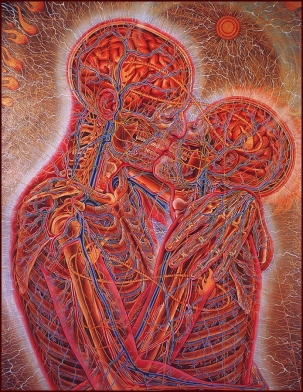

Figure 1. Alex Grey, Kissing, 1983
Figure 2. Salvador Dali, The Persistence of Memory , 1931
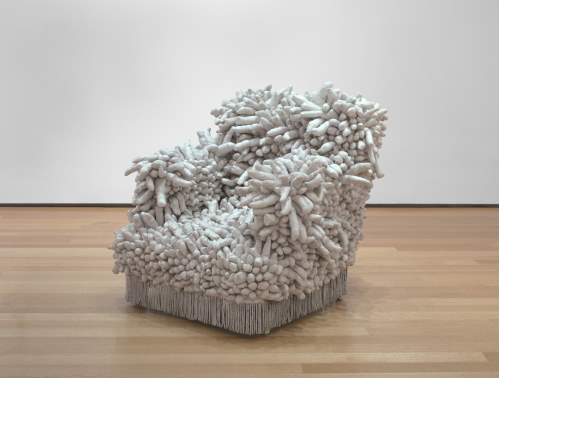




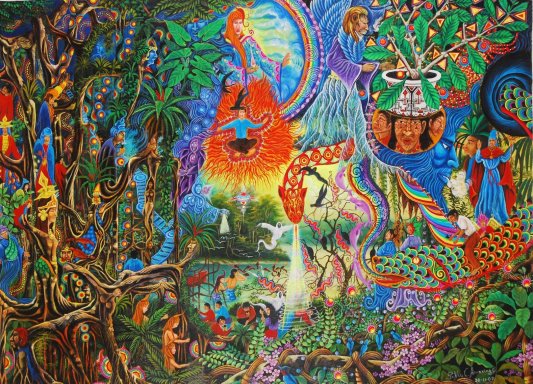
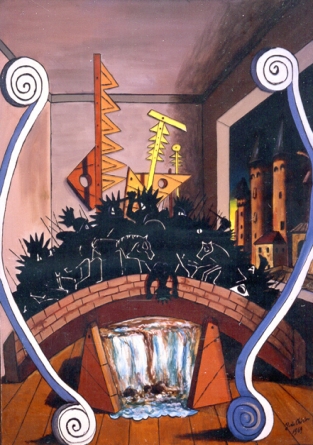
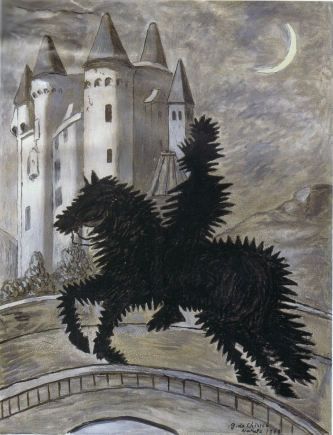
 Bibliography
Bibliography
- Dali Paintings . (2011). Retrieved from Salvador Dali, and his paintings: https://www.dalipaintings.com/ – Date Accessed: 27/10/19
- McLeod, S. (2009). Unconscious Mind. Retrieved from Simply Psychology: https://www.simplypsychology.org/unconscious-mind.html – Date Accessed:27/10/19
- R.Costa, F. M. (2015, December ). Dalí and the ant: face to face with the superior being. Retrieved from Salvador Dali: https://www.salvador-dali.org/en/research/archives-en-ligne/download-documents/19/dali-and-the-ant-face-to-face-with-the-superior-being – Date Accessed:27/10/19
- Shabi, K. (2013, May 30). Legomenon. Retrieved from Salvador Dali Persistence of Memory: Meaning of the Melting Clocks: https://legomenon.com/salvador-dali-persistence-of-memory-melting-clocks-meaning.html – Date Accessed:29/10/19
- Surrealism, In the Beginning. (2019, October 30). Retrieved from https://science.jrank.org/pages/11371/Surrealism-In-Beginning.html – Date Accessed:1/11/19
- Thunderbird. (2013, March 23). Dreamland The Art of Dreaming, Putting our Dreams to Practical use. Retrieved from Dreamland The Art of Dreaming : https://doowans.com/dreamland-the-art-of-dreaming/ – Date Accessed:1/11/19
- YiTing, P. (2019, October 27). Surrealism: Art of Subconsciousness . Retrieved from https://digitalworks.union.edu/theses/68/ – Date Accessed:1/11/19
- Episode 56 – Alex Grey & Allyson Grey. (2016, May 8). Retrieved from The Human Experience [Podcast]: https://thehumanxp.com/episode-56-alex-grey-allyson-grey/ – Date Accessed:4/11/19
- Cole, R. (2019, June 21). Yayoi Kusama. Retrieved from Encyclopaedia Britannica: https://www.britannica.com/biography/Yayoi-Kusama – Date Accessed:4/11/19
- Munroe, A. (1989). Yayoi Kusama: A Retrospective . New York: Center for International Comtemporary Arts . Retrieved from ALEXANDRA MUNROE BLOG: http://www.alexandramunroe.com/obsession-fantasy-and-outrage-the-art-of-yayoi-kusama/ – Date Accessed:4/11/19
- Tate. (2012, Feburary 12). Yayoi Kusama – Obsessed with Polka Dots . Avaliable at: https://www.youtube.com/watch?v=rRZR3nsiIeA – Date Accessed:6/11/19
- Yoshimoto, M. (2005). Into Performance, Japanese Woman Artists in New York. Rutgers University Press. – Date Accessed: 6/11/19
- Zelevansky, L. (1998). Love Forever: Yayoi Kusama, 1958-1968. Los Angeles: Los Angeles County Museum of Art. – Date Accessed:6/11/19
- Carter, T. (2017, April 7). The Polka Dot Princess’s Fear of the Phallus. Retrieved from Dirge Magazine: https://web.archive.org/web/20170419081748/http://www.dirgemag.com/polka-dot-princesss-fear-phallus/ – Date Accessed: 6/11/19
- Administration. (2019, March 19). IN DOT SPACE: the infinite world of Yayoi Kusama. Retrieved from KNITSONIK: https://www.knitsonik.com/2019/03/19/in-dot-space-the-infinite-world-of-yayoi-kusama/ – Date Accessed: 6/11/19
- Yayoi Kusama and psychedelic schizophrenia. (n.d.). [blog] Retrieved from Unit London: https://theunitldn.com/blog/67/ – Date Accessed: 6/11/19
- Ferreira, R. (2018, 4 April). 4 Artists Who Suffered Mental Illness (And How It Affected Their Art). Retrieved from Daily Art Magazine : https://www.dailyartmagazine.com/artists-who-suffered-mental-illness/ – Date Accessed:10/11/19
- Johnstone, C. F. (2003). Schizophrenia: A Very Short Introduction. Oxford: Oxford University Press Inc. – Date Accessed: 10/11/19
- Mueser, D. K. (2004). Schizophrenia . The Lancet, 2063-2072. – Date Accessed: 10/11/19
- Schizophrenia. (2019, October 4). Retrieved from World Health Organization: https://www.who.int/news-room/fact-sheets/detail/schizophrenia – Date Accessed: 10/11/19
- Ferreira, R. (2018, 4 April). 4 Artists Who Suffered Mental Illness (And How It Affected Their Art). Retrieved from Daily Art Magazine : https://www.dailyartmagazine.com/artists-who-suffered-mental-illness/ – Date Accessed: 10/11/19
- Cute Cats and Psychedelia: The Tragic Life of Louis Wain . (2016, November ). Retrieved from Illustration Chronicles : https://illustrationchronicles.com/Cute-Cats-and-Psychedelia-The-Tragic-Life-of-Louis-Wain – Date Accessed: 10/11/19
- Wrathall, C. (2000, August 13). Crazy cats and the tale of a tortured artist . Independent. – Date Accessed: 10/11/19
- Ahimsaplanthealing. (2018, July 2). Plant Consciousness: A Shaman, A Hallucinogenic Tea, and the Global Ecological Crisis. Retrieved from Ahimasa Plant Healing: https://ahimsaplanthealing.com/2018/07/02/plant-consciousness-a-shaman-a-hallucinogenic-tea-and-the-global-ecological-crisis/ – Date Accessed:18/11/19
- Domínguez-Clavé, E., Soler, J., Elices, M., Pascual, J., Alvarez, E., de la Fuente Revenga, M., . . . Riba, J. (2016). Ayahuasca: Pharmacology, neuroscience and therapeutic potential. Brain Research Bulletin, 89-101. – Date Accessed: 18/11/19
- Nimmo, S. (n.d). Plant Consciousness: A Shaman, A Hallucinogenic Tea, and the Global Ecological Crisis. Retrieved from The Courtauld’s Website: http://sites.courtauld.ac.uk/cuaj/wp-content/uploads/sites/5/2017/07/CUAJ-SUZIE-PLANTS.pdf – Date Accessed: 18/11/19
- Pablo Amaringo – Artist, Painting, Spirituality . (n.d.). Retrieved from Visual Melt: https://visualmelt.com/Pablo-Amaringo – Date Accessed: 19/11/19
- Chirchiglia, D. (2018, August 13). De Chirico and Alice in Wonderland Syndrome: When Neurology Creates Art. Retrieved from US National Library of Medicine National Institutes of Health: https://www.ncbi.nlm.nih.gov/pmc/articles/PMC6099085/ – Date Accessed:25/11/19
- Conscious Awareness. (N.D). Retrieved from Conscious Awareness : https://www.consciousawareness.info/alex-grey – Date Accessed:2/12/19
Cite This Work
To export a reference to this article please select a referencing stye below:
Related Services
View allDMCA / Removal Request
If you are the original writer of this essay and no longer wish to have your work published on UKEssays.com then please click the following link to email our support team:
Request essay removal



